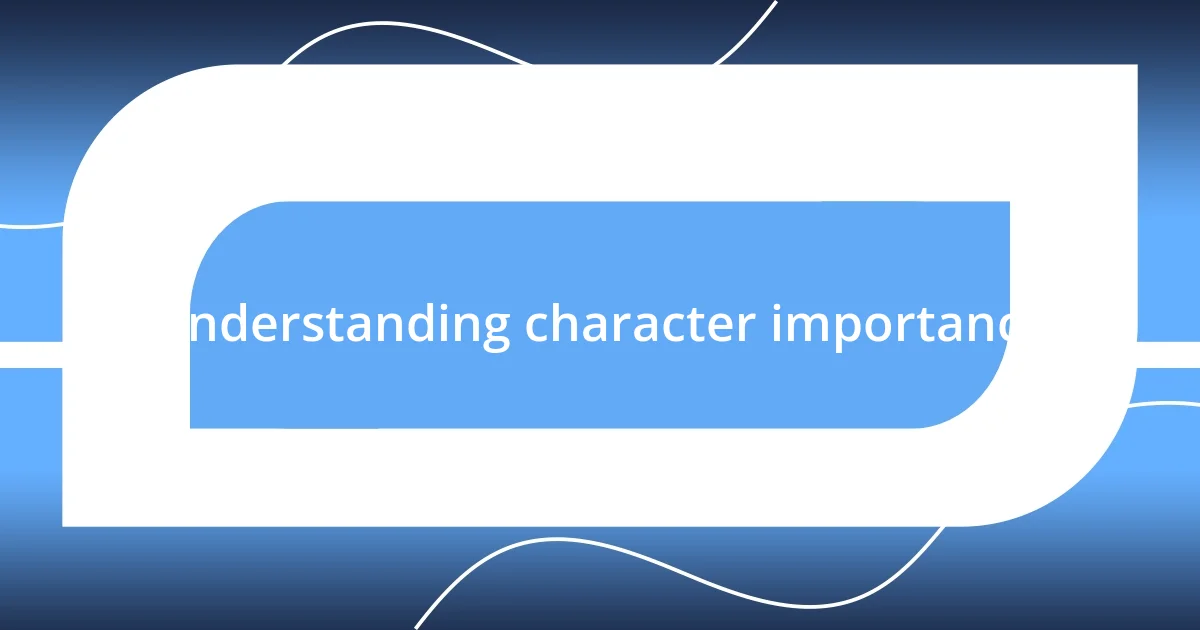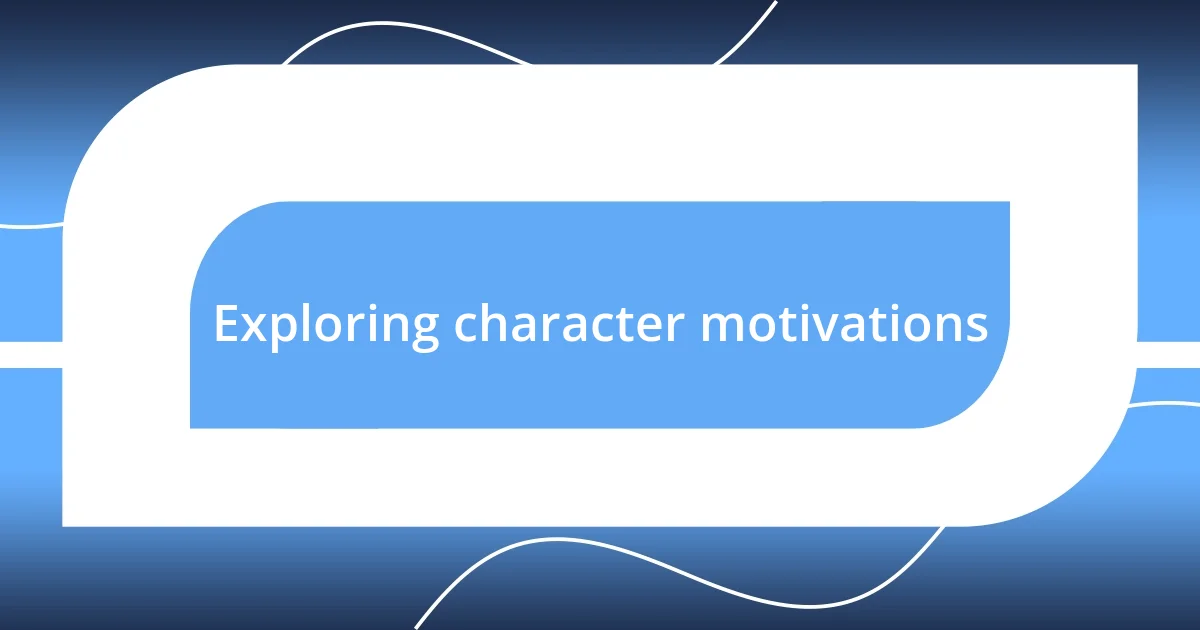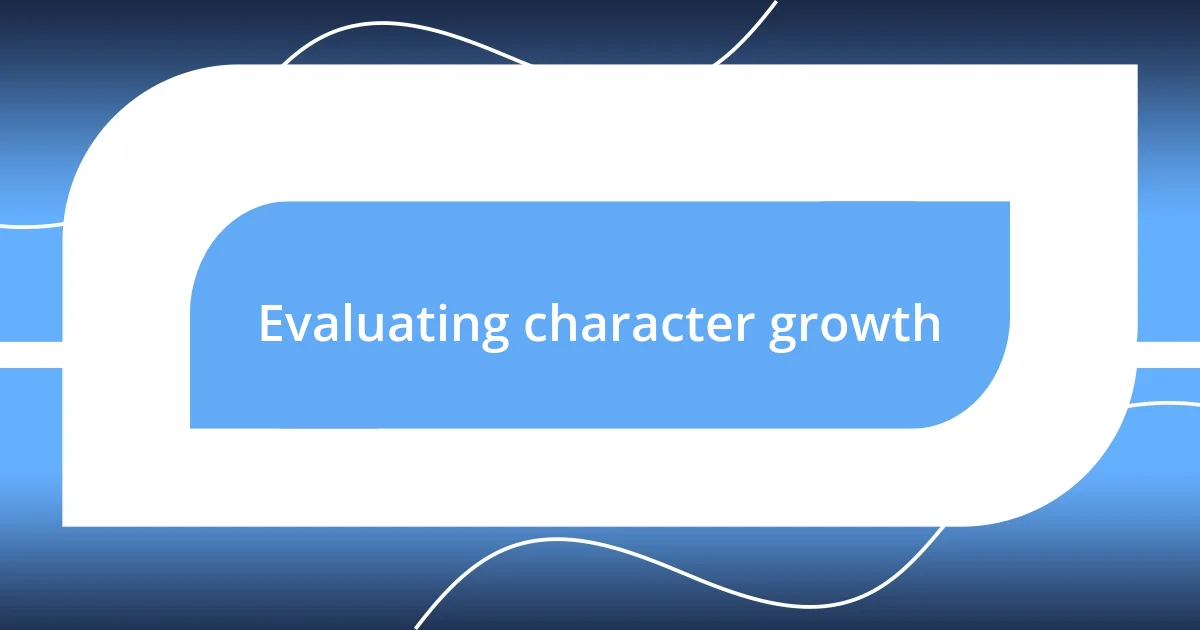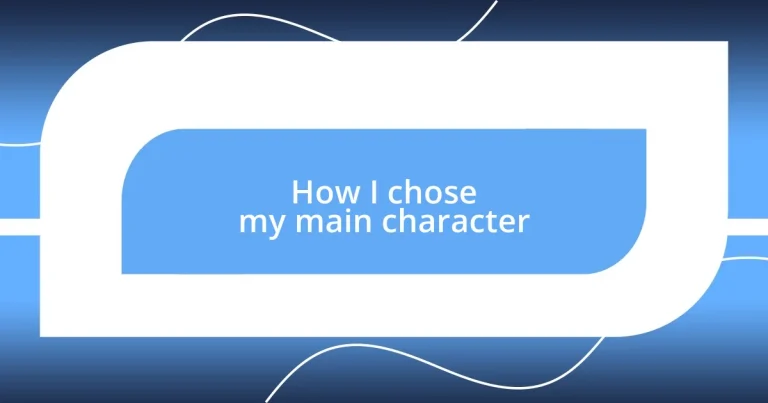Key takeaways:
- Characters are essential to storytelling, influencing emotional engagement and reader reflection on universal truths.
- Defining key character traits and motivations adds depth, drives conflict, and fosters reader connection, allowing for authentic character development.
- Evaluating character growth and selecting appropriate archetypes enhances narrative richness, reflecting personal experiences and relatable struggles.

Understanding character importance
Characters are the heart of any story; they’re the lenses through which readers experience the narrative. I remember the first time I connected deeply with a character — it was a moment of sheer revelation for me. Have you ever experienced that? When a character’s struggle mirrored your own, it made the story not just a tale, but a reflection of life itself.
Understanding a character’s importance goes beyond their role in the plot; it’s about emotional resonance. A well-crafted character can evoke joy, sadness, and everything in between, leaving a lasting impression in the reader’s mind. For instance, I once spent hours crafting the backstory of a side character, only to realize that their experiences brought a unique depth to the main character’s journey. It was a small revelation that transformed how I approached character development altogether.
Think about this: why do some characters linger in our thoughts long after we’ve closed the book? I believe it’s because they represent universal truths or struggles that resonate with our own lives. Characters can challenge our perceptions or help us process our emotions, and discovering their importance while writing not only enhances the story but also enriches our own understanding of humanity.

Defining key character traits
Defining key character traits is essential in creating an authentic and engaging character that readers can relate to. I often start by asking myself what makes a character believable. For example, one of my main characters had a fear of heights. This trait wasn’t just a quirk; it stemmed from a traumatic childhood experience. Such a backstory allows readers to empathize with their struggles, which I think is crucial for drawing them into the narrative.
When I flesh out traits, I also consider how they interact with each other. A character who is fiercely independent might clash beautifully with a supporting character who craves connection. This dynamic not only creates tension but also adds layers to their interactions. I’ve found this approach opens up exciting avenues for character growth. Imagine a character who challenges their own attributes; that’s a journey readers love to explore.
Finally, I always map out the traits to see how they influence the character’s decisions. Do they lead with their heart, or are they logical thinkers? I recall the character I created who was torn between helping a friend and adhering to their moral code. This internal conflict not only defined them but also made the story richer. Reflecting on the decision-making process can unveil deeper insights into both the character and the narrative itself.
| Character Trait | Impact on Story |
|---|---|
| Fear of Heights | Creates tension in critical moments, enhances emotional depth. |
| Independence | Drives character conflict, fosters dynamic relationships with others. |
| Logical Thinking | Shapes decision-making, adds complexity to moral dilemmas. |

Exploring character motivations
Exploring character motivations
Character motivations are the driving force behind their actions and decisions, which can make or break a narrative. I once spent an entire weekend dissecting what truly motivated my main character to pursue a seemingly reckless goal. That process not only added depth to their journey but also sparked a real sense of connection within me as a writer. I realized that understanding a character’s desires is like unlocking a door to their soul.
When I think about motivations, I often break them down into a few key areas that shape the character’s journey and resonate with readers:
- Personal Desire: What does the character want most? This could range from love to power, pushing them to take risks.
- Fear of Failure: Sometimes it’s not just about what they want, but what they’re terrified of losing that fuels their actions.
- Influence from Others: External pressures from family, friends, or society can lead to motivations that drive the narrative in unexpected ways.
- Past Experiences: A character’s history shapes their decisions; for instance, a betrayal can ignite a quest for revenge or a search for redemption.
Understanding these layers has helped me create more relatable characters. I remember developing a character who was motivated by a deep-seated need for approval after years of feeling inadequate. This revelation brought them to life for me, making their triumphs and struggles all the more impactful.

Analyzing character conflicts
Analyzing character conflicts can be a fascinating aspect of storytelling. I remember when I was creating a character caught in a love triangle—an internal battle of desire versus loyalty. This tension not only heightens drama but also allows for exploration of their motivations, pushing them to confront their own desires. I often wonder, how does a character reconcile their heart with their sense of obligation? This conflict can really drive the narrative forward.
There’s something thrilling about watching characters clash with their surroundings or themselves. For instance, I had a character who struggled between withdrawing from their community or embracing it, stemming from a fear of vulnerability. This inner turmoil manifested in their interactions, creating moments of friction that revealed their true self. Isn’t it interesting how such conflicts can unveil not only a character’s strengths but also their insecurities?
I also think about external conflicts, like how a protagonist’s wishes might be at odds with societal expectations. I once developed a character who wanted to pursue an unconventional career, defying a family tradition of medical professionals. The push and pull between their dreams and familial duty created a rich layer of conflict, showcasing both their courage and vulnerability. Reflecting on these dynamics can deepen the readers’ connection to the character, inviting them to share in their journey of self-discovery.

Evaluating character growth
Evaluating character growth is a crucial step in crafting a memorable narrative. I often find myself reflecting on how my characters evolve over the course of their journeys. For example, I once had a character who began as a self-centered individual, focused solely on personal gain. As I wrote, I explored their relationships and the consequences of their actions, allowing them to gradually realize the importance of empathy. Observing this transformation was not just satisfying; it deeply resonated with my own experiences, reminding me how growth often stems from moments of vulnerability.
I can’t help but think about how significant milestones in a character’s arc can evoke strong emotions. I remember drafting a scene where my character faced a heartbreaking loss that prompted a reevaluation of their priorities. That moment became a turning point, illustrating that growth often arises from struggle. How do we not just write these transformations but also reflect on our own lives? I believe that as writers, we can channel our experiences to create characters whose growth feels authentic.
It’s fascinating to track the stages of growth alongside the character’s decision-making process. I once outlined a character who, after being confronted with their own flaws, had to choose between staying in their comfort zone or risking it all for change. That struggle mirrored my own fears at times—whether to play it safe or leap into the unknown. This parallel not only added depth to my character’s journey but also created a powerful connection with my audience, inviting them to ponder their own paths of growth and transformation. Isn’t that what we all seek, a sense of evolving alongside the characters we create?

Selecting the right archetype
Selecting the right archetype can truly shape the essence of a character. I remember pondering over the classic Hero archetype for my story, which felt both thrilling and daunting. Would my audience connect with a character who fits this mold, or would they crave something more nuanced? It’s like that moment when you’re picking a flavor of ice cream—do you go classic, or do you dare to try the unexpected?
In my experience, going deeper than surface traits is essential. I once combined the Mentor and Rebel archetypes, creating a character who initially feels authoritative but gradually reveals a fierce defiance against the very rules they enforce. This juxtaposition not only added complexity but also invited readers to question their own perceptions of authority. What happens when we challenge the norms we’ve always accepted? These inner clashes can resonate with readers, reflecting their struggles and aspirations.
I’ve also seen the power of archetypes in creating relatable experiences. Think about the Everyman archetype—characters that embody the ordinary. I crafted a story around a barista whose dreams felt out of reach, mirroring my own moments of self-doubt. When readers encounter these archetypes, they often find fragments of their own lives in them. Isn’t it invigorating to explore characters that mirror the intricacies of our daily struggles and triumphs? This connection can elevate the narrative, inviting readers to embark on a deeper journey with the characters.














